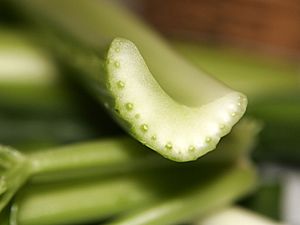Vascular tissue facts for kids
- This is an article about vascular tissue in plants. For transport in animals, see Circulatory system.

Imagine plants having their own special delivery system, just like our bodies have blood vessels! This system in plants is called vascular tissue. It's a group of special cells that work together to move water, nutrients, and food all around the plant.
Vascular tissue is a "complex tissue" because it's made of more than one type of cell. These cells are organized into tubes that stretch from the roots, through the stem, and into the leaves. Without this amazing system, plants couldn't grow tall or get the things they need to make their own food!
Contents
What is Vascular Tissue?
Vascular tissue is like the plant's plumbing system. It helps plants transport important liquids and nutrients from one part to another. This is why plants can grow so big, unlike simpler plants like mosses that don't have this system.
The two main parts of vascular tissue are the xylem and the phloem. Think of them as two different kinds of pipes, each with a special job. Together, all the vascular tissues in a plant form its vascular tissue system.
Xylem: The Water Highway
The xylem is like the plant's water pipeline. Its main job is to carry water and dissolved minerals from the roots, where they are absorbed from the soil, all the way up to the leaves. This water is super important for photosynthesis, which is how plants make their food.
Xylem tissue is made of strong, hollow cells that are like tiny tubes. These tubes also help support the plant, giving it strength to stand upright. Without xylem, a tall tree couldn't get water to its highest branches!
Phloem: The Food Delivery System
The phloem is the plant's food delivery service. After the leaves make sugar (food) through photosynthesis, the phloem transports this sugar to all other parts of the plant. This includes the roots, fruits, and growing tips, where the energy is needed for growth and storage.
Unlike xylem, which mostly moves water upwards, phloem can move food in any direction – up or down – depending on where the plant needs it most. It's a very flexible system!
Vascular Cambium: The Growth Engine
There's also a special growth area connected to the vascular tissue called the vascular cambium. This is a layer of cells that can divide and make new xylem and phloem cells.
The vascular cambium is responsible for the plant's growth in width, especially in trees. Each year, it adds new layers of xylem (which become the tree's wood) and phloem, making the trunk thicker. This is how we see tree rings when a tree is cut down – each ring represents a year's growth from the cambium!
Related pages
See also
 In Spanish: Tejido vascular para niños
In Spanish: Tejido vascular para niños

